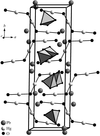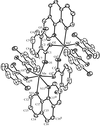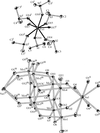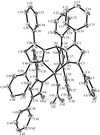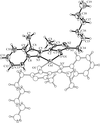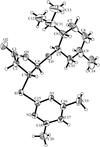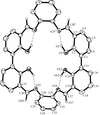issue contents
June 2005 issue

Cover illustration: The hydrogen-bonding pattern in 6-methyl-2-pyridone, forming infinite chains. See Nichol & Clegg [Acta Cryst. (2005), C61, o383-o385].
inorganic compounds
Download citation


Download citation


A new three-dimensional bimetallic tellurite, BaV2TeO8, was synthesized by the hydrothermal reaction of Ba(OH)2, TeO2 and V2O5, and characterized by single-crystal X-ray diffraction. The three-dimensional framework is built up from anionic [V2TeO8]n2n− layers parallel to (101) and connected via Ba—O bonds. The anionic layers are formed by three types of polyhedra, namely VO5 tetragonal pyramids, VO4 tetrahedra and TeO4+2 `folded square' polyhedra.
Download citation


Download citation


The structure of Ce(IO3)3 consists of chains of edge-sharing CeO9 polyhedra, which are linked into layers by IO3− groups. The layers are held together via long I⋯O contacts, resulting in a three-dimensional network.
Download citation


Download citation


Pb2(Hg3O4)(CrO4) consists of isolated CrO42− tetrahedra and Hg3O42− zigzag chains connected by interstitial Pb atoms. The Hg atoms are linearly coordinated by O atoms; the divalent lead ions are coordinated by three close and five more distant neighbours.
Download citation


Download citation


The structure of rubidium gadolinium bis(tungstate), RbGd(WO4)2, has been determined. The crystal is built up from corner- and edge-sharing WO6 octahedral and GdO8 polyhedral groups, giving rise to a Gd–WO4 polyhedral backbone surrounding structural cavities filled with Rb+ cations. The Gd and Rb atoms lie on twofold axes.
Download citation


Download citation


The novel title compound, poly[octa-μ-aqua-octaaqua-μ-decavanadato-hexalithium], contains [V10O28]6− polyanions with 2/m symmetry linked by centrosymmetric [Li6(H2O)16]6+ cation chains to form a two-dimensional network structure.
metal-organic compounds
Download citation


Download citation


Open  access
access
 access
access Download citation


Download citation


Download citation


Download citation


Download citation


Download citation


Download citation


Download citation


Download citation


Download citation


Download citation


Download citation


Download citation


Download citation


Download citation


Download citation


Download citation


Download citation


Download citation


Download citation


Download citation


Download citation


Download citation


Download citation


Download citation


Download citation


Download citation


Download citation


Download citation


Download citation


Download citation


Download citation


Open  access
access
 access
access Download citation


Download citation


Download citation


Download citation


Download citation


Download citation


Download citation


Download citation


Download citation


Download citation


The title oxyfluorinated gallium phosphate exhibits a two-dimensional network intercalated by the diprotonated propane-1,3-diaminium moiety. This compound is isostructural with the aluminophosphate having the MIL-12 structure type.
Download citation


Download citation


organic compounds
Download citation


Download citation


Download citation


Download citation


Download citation


Download citation


Download citation


Download citation


Download citation


Download citation


Download citation


Download citation


Download citation


Download citation


Download citation


Download citation


Download citation


Download citation


Open  access
access
 access
access Download citation


Download citation


Download citation


Download citation


Download citation


Download citation


Download citation


Download citation


Open  access
access
 access
access Download citation


Download citation


Download citation


Download citation


Download citation


Download citation


Download citation


Download citation


Download citation


Download citation


Open  access
access
 access
access Download citation


Download citation


Open  access
access
 access
access Download citation


Download citation


Download citation


Download citation


Open  access
access
 access
access Download citation


Download citation


Open  access
access
 access
access

 journal menu
journal menu













